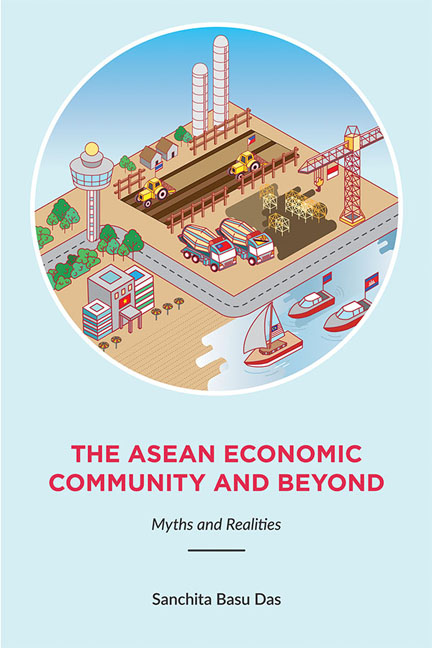Book contents
- Frontmatter
- Dedication
- Contents
- Foreword
- Acknowledgements
- Abbreviations
- 1 Introduction: The ASEAN Economic Community and Beyond
- I THE ASEAN ECONOMIC COMMUNITY (AEC)
- II BEYOND THE ASEAN ECONOMIC COMMUNITY
- III AN ASEAN PERSPECTIVE OF REGIONAL CONNECTIVITY
- Appendix: Summary of the Trans-pacific Partnership Agreement
- Index
- About the Author
1 - Introduction: The ASEAN Economic Community and Beyond
Published online by Cambridge University Press: 19 May 2017
- Frontmatter
- Dedication
- Contents
- Foreword
- Acknowledgements
- Abbreviations
- 1 Introduction: The ASEAN Economic Community and Beyond
- I THE ASEAN ECONOMIC COMMUNITY (AEC)
- II BEYOND THE ASEAN ECONOMIC COMMUNITY
- III AN ASEAN PERSPECTIVE OF REGIONAL CONNECTIVITY
- Appendix: Summary of the Trans-pacific Partnership Agreement
- Index
- About the Author
Summary
The ten countries of Southeast Asia — Brunei, Cambodia, Indonesia, Laos, Malaysia, Myanmar, the Philippines, Singapore, Thailand and Vietnam — are achieving a major milestone of an ASEAN Community (AC) by the end-2015. The ASEAN Community comprises of three pillars — ASEAN Political Security Community, ASEAN Economic Community (AEC) and ASEAN Socio-cultural Community. While the ASEAN Political-Security Community calls for a “rules-based community of shared values and norms”, good governance, human rights, and adherence to the principles of democracy; the ASEAN Socio-cultural pillar covers a wide range of areas — education, information and communication technology, poverty alleviation, migration, natural disasters, entrepreneurship, social safety nets and the environment. The ASEAN Economic Community aims to deliver on an integrated production space with free movement of goods, services, and skilled labour.
According to the April 2015 Summit, there has been positive progress in building an ASEAN Community since 2009. In particular, the AEC, because of its quantitative nature and expected tangible benefits, has attracted relatively more attention and is said to have achieved 90.5 per cent of its targeted 506 priority measures. This volume focuses on the ASEAN Economic Community and other economic initiatives arising out of it.
It should be noted that the ASEAN countries combined constitute a population of about 625 million, spanning a total area of 4.5 million square kilometres. In 2013, the ASEAN countries together generated a combined gross domestic product (GDP) of US$2.4 trillion and total trade of US$2.5 trillion, accounting for almost a quarter of Asia's total exports and imports.
THE ASEAN ECONOMIC COMMUNITY (AEC)
The ASEAN Vision 2020, adopted in December 1997, envisaged “a stable, prosperous and highly competitive ASEAN economic region in which there is a free flow of goods, services, investment and freer flow of capital, equitable economic development and reduced poverty and socioeconomic disparities” by the year 2020. To realize this vision, the ASEAN leaders signed the Declaration of ASEAN Concord II at the ASEAN Summit in October 2003, aiming for an AEC as an end goal of its economic integration. Later, the deadline was brought forward to 2015.
ASEAN achieved a major milestone at the November 2007 ASEAN Summit when its leaders adopted the AEC Blueprint, which laid out a road map to achieve the economic integration, and included action plans, targets and timelines to facilitate the process.
- Type
- Chapter
- Information
- The ASEAN Economic Community and BeyondMyths and Realities, pp. 1 - 8Publisher: ISEAS–Yusof Ishak InstitutePrint publication year: 2015

